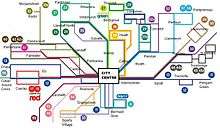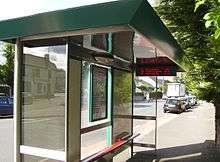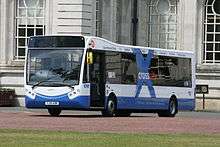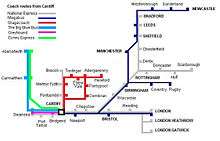Bus transport in Cardiff

Bus transport in Cardiff, the capital and most populous city in Wales, forms the major part of the city's public transport network, which also includes water, air travel and an urban rail network. Cardiff is a major city of the United Kingdom and a centre of employment, retail, business, government, culture, media, sport and higher education.
Most of the city's comprehensive bus network is operated by Cardiff Bus, owned by Cardiff County Council. The main hub and terminus of the network is Cardiff Central bus station, also known as Central Station which closed for redevelopment in the autumn of 2015. Cardiff Bus also operates the X91 to Llantwit Major omitting the airport which is now served by the Traws Cymru T9 Route.
Other operators such as Stagecoach in South Wales and Newport Bus link the city with other urban areas in South Wales. TrawsCymru operates a long distance route to Aberystwyth, Cardiff Airport and West Wales, whereas National Express, Greyhound and Megabus operate long distance coaches to towns and cities throughout Wales, Scotland and England.
History
Trams
Horse buses had run in the city from 1845 until 1909 and horse trams from 1872 until 1904. The first tram route ran from High Street in the city centre to the Docks run by the Cardiff Tramway Company.[1] In 1898, Cardiff County Borough Council obtained Parliamentary powers to take over all the tramways in the area and go ahead with the new electric trams, owning them from 1903. The routes formally opened in May 1902 with the first recorded accident later that month – a collision with a cyclist. In 1904, more than 23 million passengers had been carried in that year, up from 18 million the previous year.[1] and when Cardiff became a city in 1905, 131 electric trams were operating on the network, mainly focusing on the busy Cardiff Docks.[2] In 1928, the network peaked at 142 cars and 19.5 miles (31.3 km) route miles.[3] By 1929, the tram network stretched from Victoria Park in the west, to Grangetown and Cardiff Docks in the south, to Roath and Splott in the east, and to Gabalfa in the north.[1]
The city council refused motor buses in 1907 but allowed them in 1910, operating its own from 1920, although 81 tramcars were introduced by Cardiff Corporation Transport to negotiate the city's low railway bridges. By 1939, these vehicles were becoming worn out and it was decided to phase out tramcars.
Trolleybuses and motor buses

In 1942, trolleybuses began to replace tramcars. The last tram service ran to Whitchurch in February 1950, making it the last place in Britain to commence trolleybus operation after Glasgow.[3] Trolleybus routes were generally the same as tram routes although extensions were made.[3] The furthest and final extension of the network came in 1955, to Ely, where trams had never run.[2] At this point, the system peaked at 79 vehicles and 18 route miles.[3]
In 1959, the Cardiff Corporation Transport (later City of Cardiff Transport) routes, with trolleybus routes in bold, were[2]
|
|
|
Trolleybuses stopped on Wood Street, rather than in Cardiff Central bus station. Transition to motor buses began in 1962 and was completed by 1970, bringing to an end 68 years of electric traction on the streets of Cardiff. The city has been served by motor buses ever since.[3] Cardiff had the largest municipal bus fleet in South Wales with 253 buses. The fleet of 1960s and 70s maroon and cream double-deckers included AEC Regent V, Daimler Fleetline and Guy Arab V. It also operated single deckers including AEC Swift.[4]
Other operators
Between the 1960s and 1980s, Cardiff had many small coach operators:[4][5]
Western Welsh was formed in 1929 and grew to cover an area from St. David's in West Wales to the English border, operating 319 buses in its South Wales fleet by 1970. In 1978 it became National Welsh/Cymru Cenedlaethol which also ran Red & White. The two companies closed in 1992.
Neath & Cardiff's brown and red AEC Reliance fleet operated to towns to the west, to Bridgend, Neath and Swansea in the 1970s. Its coaches were known as brown bombers.
In June 1970, Alan Barrington Smith operated the 59 service from Newport to Cardiff, previously operated by Davies and Baldwin and Red & White, using Bristol vehicles. This route was acquired by Smiths in 1972 and incorporated into their route 31 that circled Newport, but dropping the extension to Cardiff.
CK Coaches Ltd was formed in 1974. In 1981, it gained two routes in the capital charging lower fares and offering the first competition for the Cardiff municipal fleet within the city since 1927. Leyland buses were bought from London Transport Fleetlines and Leicester City Transport for these routes, one of which was the 54 to Cyncoed, and had a white and orange livery, similar to that of Cardiff Bus, but making more use of the white colour. Its blue and white double deckers operated a Llanrumney route, serving the heavily populated eastern suburb. CK Coaches later operated a route to Llanedeyrn, and used Wood Street in the city centre rather than the main stands of Central Station. The company's licences were revoked on 31 March 1982, ceasing the services.
Falconer and Watts operated tours and excursions, private hire and some contracts from Llanishen, a suburb to the north of Cardiff from 1919 to 1982, when they were taken over by Warners Fairfax of Tewkesbury.[6]
Thomas Motor Services had a history in Barry since 1914. At one time, it operated the sole bus link between Barry and Cardiff via Dinas Powys. Its Leyland Tigers ran on the route 304 from 1959 until 1970, and Leyland Leopards taking over until 1982. Thomas continued to operate the route using coaches.
Greyhound's fleet consisted of around a dozen coaches in a blue and ivory livery. Some were used for local school contracts, such as at St Teilo's in the Penylan area of Cardiff. Equally, Coastal Continental Coach Hire, who ceased trade in 2008, operated Leyland Atlanteans in a red and cream colour on school routes for Ysgol Gyfun Gymraeg Glantaf in Llandaff North.
Bus stops

Over 300 city bus stops have passenger information panels that display the estimated arrival times of bus services.[7] This information can also be found online.[8]
School Buses
Many school buses are operated by companies such as NAT Group, Cardiff Bus and Edwards Coaches. These are operated by school coaches or low floor double deckers.
Cardiff Central bus station
Cardiff Central bus station, on Wood Street, is the hub of the city's and South Wales' bus and coach network. With 34 stands, it is the largest bus station in the city and in Wales. It is located adjacent to Cardiff Central railway station forming a major bus-rail-cycle-taxi interchange.
Demolition and reconstruction began in 2008 with the terminus building being demolished. As a result, changes to stands and bus stops are expected and the stands given in this article may not be up to date. Before work began, there were 8 concourses lettered A-F and W (on Wood Street) with each concourse having numbered stands. Today, the stands are numbered B1-F2, JA-JD and JT-JQ.
The station handles the vast majority of bus and coach services that run in and through the city. Cardiff Bus accounts for 72 per cent of all bus services stopping at Cardiff Central bus station by frequency.[9]
Eating and drinking facilities, such as a Burger King as well as other shops and bus company offices, face the concourses on Central Square. Taxi ranks are located on both sides of the station. Toilets and a newsagent were located at stand A which was demolished in summer 2008 as part of the redevelopment of the station. However, these services are available in the adjacent Cardiff Central railway station.
On 1 August 2015, the Cardiff Central bus station closed down as a part of wider developments in the Cardiff area. An improved station is planned to open December 2017.
City centre

Most city bus services call at other significant bus stops in the centre.[10][11] All city centre bus stops have a two letter code and most are found in clusters.
Interchanges and integration
Cardiff's transport network also consists of rail, taxi, cycle, water and air transport.
Cardiff Central bus station is located directly next to Cardiff Central railway station, facilitating the bus-rail interchange. However, many services stop at some of the other 19 stations in the city on the Valley Lines network.
Bus services integrate with the Cardiff Waterbus at Central Station (for Taff Mead Embankment) and Cardiff Bay for (Mermaid Quay). The X91 bus service operated by Cardiff Bus connects the city centre to Cardiff International Airport. Taxi ranks and cycle stands are located at Central Station.
Local services and operators
Cardiff City Centre Bus Box | |||||||||||||||||||||||||||||||||||||||||||||||||||||||||||||||||||||||||||||||||||||||||||||||||||||||||||||||||||||||||||||||||||||
|---|---|---|---|---|---|---|---|---|---|---|---|---|---|---|---|---|---|---|---|---|---|---|---|---|---|---|---|---|---|---|---|---|---|---|---|---|---|---|---|---|---|---|---|---|---|---|---|---|---|---|---|---|---|---|---|---|---|---|---|---|---|---|---|---|---|---|---|---|---|---|---|---|---|---|---|---|---|---|---|---|---|---|---|---|---|---|---|---|---|---|---|---|---|---|---|---|---|---|---|---|---|---|---|---|---|---|---|---|---|---|---|---|---|---|---|---|---|---|---|---|---|---|---|---|---|---|---|---|---|---|---|---|---|
Legend
| |||||||||||||||||||||||||||||||||||||||||||||||||||||||||||||||||||||||||||||||||||||||||||||||||||||||||||||||||||||||||||||||||||||
Cardiff Bus
.jpg)
Cardiff Bus is the dominant bus operator in Cardiff and also serves Penarth, Sully, Barry and Llantwit Major. Its network consists of 64 routes[12] using Scania OmniCity, Scania N230UD, East Lancs Olympus and bendy buses, Adl Enviro 200 Enviro 300 and Enviro 400 MMC, also use Dennis dart MPDs LMPDs and SPDs and Mercedes-Benz Citaros are also used. Cardiff Bus carries 100,000 passengers daily, has a turnover of £27million and employs around 720 people.[13] The fleet and drivers are managed against a timetable using software systems supplied by UK based software supplier Omnibus Systems,[14] which allows the real-time digital information displays positioned at many stops around the city, to inform people when the next bus is due and alerting waiting passengers of any delays. Raised kerbs have been installed at the majority of stops.
In addition to scheduled city buses, Cardiff Bus is contracted to operate some school routes in the city.[15]
Smart cards for Cardiff Bus passengers were trialled in spring 2009 and could be rolled out at a later stage. The options could include rechargeable cards along the lines of London’s Oyster card or fixed-price plastic cards already charged with a certain number of journeys. Pensioners’ free bus passes are also set to be equipped with smart card technology.[16]
Branded routes

Cardiff Bus operates three branded routes: Baycar, Capital City Red, and Capital City Green.
Stagecoach
Stagecoach in South Wales, which has its headquarters in Cwmbran, operates routes mainly to the South Wales Valleys from central Cardiff.
Its fleet of over 400 buses is one of the most modern in the country, and includes many low-floor, easy access buses with step-free entrances, dedicated buggy areas and wheelchair access.
It does not issue return tickets. However it issues a megarider pass for all day travel, valid from four weeks until a year.[17] The Cardiff zone stretches to Taffs Well, Creigiau, Castleton and Travellers Rest.[18]
In 2009, Stagecoach launched Wi-Fi on its X4 Cardiff-Hereford ADL/MAN Enviro 300 buses, which are themselves new, replacing older coaches that operated on the route.[19]
Then in 2015, Stagecoach replaced the ADL/MAN Enviro 300's with new ADL/Scania Enviro 300's due to MAN Enviro 300's poor reliability.
First Cymru
First Cymru, the principle operator in South West Wales, operates inter-urban services west of Cardiff, and two services within the city. They currently operate the Greyhound 100 between Cardiff and Swansea and the Cymru Clipper X2 between Cardiff and Bridgend/Porthcawl.
Newport Bus
Newport Bus, the principal operator in neighbouring Newport, operates express service between Cardiff, and Newport and Risca. It also operates a non-express to and from Newport jointly with Cardiff Bus. Like Cardiff Bus, it is a municipal bus company, owned by Newport City Council.
City Sightseeing
City Sightseeing operates timetabled open top double-decker bus tours around the city centre and the Bay, including the Millennium Stadium, Cardiff Castle, the Civic Centre, the National Museum of Wales and Alexandra Gardens on the route. The tour takes 50 minutes[20]
NAT Group

NAT Group, an expanding bus and coach company in Cardiff operate the X1 Crosscity service, launched in 2015, as well as the X11 cityXpress service, launched in 2016, both of which connect the western, central and eastern parts of the city.
They also operate Service 304 to Barry and some home-school coaches in the Cardiff area.
Edwards
Edwards Coaches operates the 400 bus service between Beddau and Greyfriars Road bus stop in Cardiff.
National operators and services

Lewis' Coaches
The Service 701 Express Coach Service is operated by Lewis' Coaches of Llanrhystud. Since 1 October 2015, they have operated a twice daily service to and from Cardiff, Bridgend, Port Talbot, Swansea, Carmarthen, Lampeter, Aberaeron and Aberystwyth.[21]
Megabus
Megabus is a low-cost no-frills intercity coach network in the United Kingdom operated by Stagecoach that commenced operations in 2003, including non-stop services to London in a journey time of three and a half hours. Other longer routes to London stop in Newport and Bristol. Cardiff is also linked by Megabus coach to Newcastle via Birmingham, Manchester, Leeds, Middlesbrough and Sunderland.
National Express
Birmingham based National Express has operated intercity coach services across the United Kingdom since 1972 and sub-contracts to Edwards Coaches the operation of routes from Cardiff to:
- Service 201 and 202 to Gatwick Airport and Heathrow Airport
- Service 320, 322 and 323 to Birmingham
- Service 322 and 509 to London and Brecon
- Service 528 to Birmingham, Swansea, Carmarthen, Tenby, Pembroke and Haverfordwest
TrawsCymru
TrawsCymru are a set of routes, set up by the Welsh Government but operated by private bus companies using the TrawsCymru branding. This service is similar to a previous service, TrawsCambria.
Service T4 is operated by Stagecoach in South Wales and connects Cardiff with Brecon and Newtown and operates up to 7 times a day.
Service T9 is operated by New Adventure Travel Group and connects the centre of Cardiff with the Cardiff International Airport and operates up to every 20 minutes. When launched, this route was originally operated by First Cymru.
Other bus services
Bus passes
Residents of Cardiff (and Wales) who are over sixty or suffering from certain disabilities, injuries or impediments are entitled to a bus pass enabling free travel across most bus services in Wales. For the Cardiff area, the following buses are exempt from this facility: National Express (including Airport Buses 200, 201 and 202), Eurolines and Megabus.
Park and ride
Park and Ride services run every weekend in Cardiff throughout the year. The cost includes bus travel to the City Centre, usually less than many multi-storey car parks. There are four Park and Ride services in the city:
The Park and Ride services are part of Cardiff council’s Sustainable Travel City initiative, which is partly funded by the Welsh Assembly Government. There are plans to extend the number of space from 340 to 1,100 due to its sudden increase in usage.[22]
Iff card
Iff card is a contactless smart card introduced by Cardiff Bus in October 2010, allowing customers to travel on its services after having pre-paid. The first 30,000 cards were issued free of charge and pre-loaded with £3 of credit, after which the cards will be charged at £5.
An amount of money is electronically loaded onto the card, either upon boarding a bus or at the Cardiff Bus customer service centre. A passenger then chooses a ticket type. The card can also be used as a season ticket. The card should be topped-up when the balance is low, however the card allows the customer to acquire a negative balance up to £3.[23]
The card can be topped-up in units of £5, £10 and £20 up to maximum amount of £50. The card may be used by persons aged between 6 and 60. The Iff card cannot be used to pay a partial amount. The card would be cancelled if not used for a continuous period of one year[24]
See also
- List of bus stations in Wales
- Bus transport in the United Kingdom
- Coach transport in the United Kingdom
- Transport in Cardiff
- Transport in Wales
- Transport in the United Kingdom
References
- 1 2 3 Gould, David (1996). Cardiff's Electric Tramways. Oxford: The Oakwood Press. ISBN 0-85361-487-3.
- 1 2 3 Davies, Roger (2006). Streets of Cardiff. Hersham, Surrey: Ian Allan Publishing. ISBN 0-7110-3098-7.
- 1 2 3 4 5 Lockwood, Stephen (2005). Cardiff Trolleybuses. Midhurst, West Sussex: Middleton Press. ISBN 1-904474-64-0.
- 1 2 Booth, Gavin (2006). Bus Operators 1970s Midlands and Wales. Hersham, Surrey: Ian Allan Publishing. ISBN 978-0-7110-3035-0.
- ↑ Wiltshire, Andrew (2009). Independent Buses of South & West Wales. Bristol: Bernard McCall. ISBN 978-1-902953-43-4.
- ↑ "Falconer and Watts – A suburban coach operator in Wales' capital".
- ↑ Steve Harrhy (24 August 2006). "Home, Bus Stop Real Time Travel Information, Bus stop Real-time Travel Information". Cardiff. Archived from the original on 9 June 2011. Retrieved 9 May 2009.
- ↑ "Real Time Information – Cardiff". Cardiff.acislive.com. Archived from the original on 27 April 2009. Retrieved 9 May 2009.
- ↑ "The Office of Fair Trading: Cardiff Bus". Oft.gov.uk. Archived from the original on 16 April 2009. Retrieved 9 May 2009.
- ↑ http://www.cardiff.gov.uk/ObjView.asp?Object_ID=9610&language=
- ↑ http://www.cardiffbus.com/pdfs/cardiff_centremap.pdf
- ↑ http://www.cardiffbus.com/pdfs/networkmap.pdf
- ↑ "Staff turnover plummets to record low levels". TUC Wales. Retrieved 2 November 2008.
- ↑ "Case Study – Cardiff Bus (Bws Caerdydd)". omnibus-systems.co.uk. Retrieved 2 November 2008.
- ↑ Nina Stedman (9 October 2008). "Home, School Bus Routes". Cardiff. Archived from the original on 9 June 2011. Retrieved 9 May 2009.
- ↑ "News – Cardiff News – Cardiff set for its own Oyster card". WalesOnline. 28 January 2009. Retrieved 9 May 2009.
- ↑ http://www.stagecoachbus.com/shop/index.php?action=&sid=20090512224948-7319&product_id=14&location_id=180&x=67&y=3
- ↑ "Archived copy". Archived from the original on 2 October 2009. Retrieved 2009-11-10.
- ↑ http://www.walesonline.co.uk/news/cardiff-news/2009/04/20/stagecoach-new-buses-offer-commuters-internet-access-91466-23421112/
- ↑ "City Sightseeing Worldwide – the world's largest open top bus tour operator". City-sightseeing.com. Retrieved 9 May 2009.
- ↑ http://www.coachtravelwales.co.uk/701%20times%20April%202012%20A5%20web.pdf
- ↑ http://www.walesonline.co.uk/news/cardiff-news/2009/12/04/new-park-and-ride-is-a-resounding-success-91466-25317759/
- ↑ Cardiff Bus | Iff
- ↑ Cardiff Bus | Iff: Terms and Conditions
External links
- Cardiff Bus
- Stagecoach South Wales
- National Express
- City Sightseeing Route Map
- Cardiff Transport Map
- Cardiff City Centre/Bay general map
- Historic photos of Central Station
